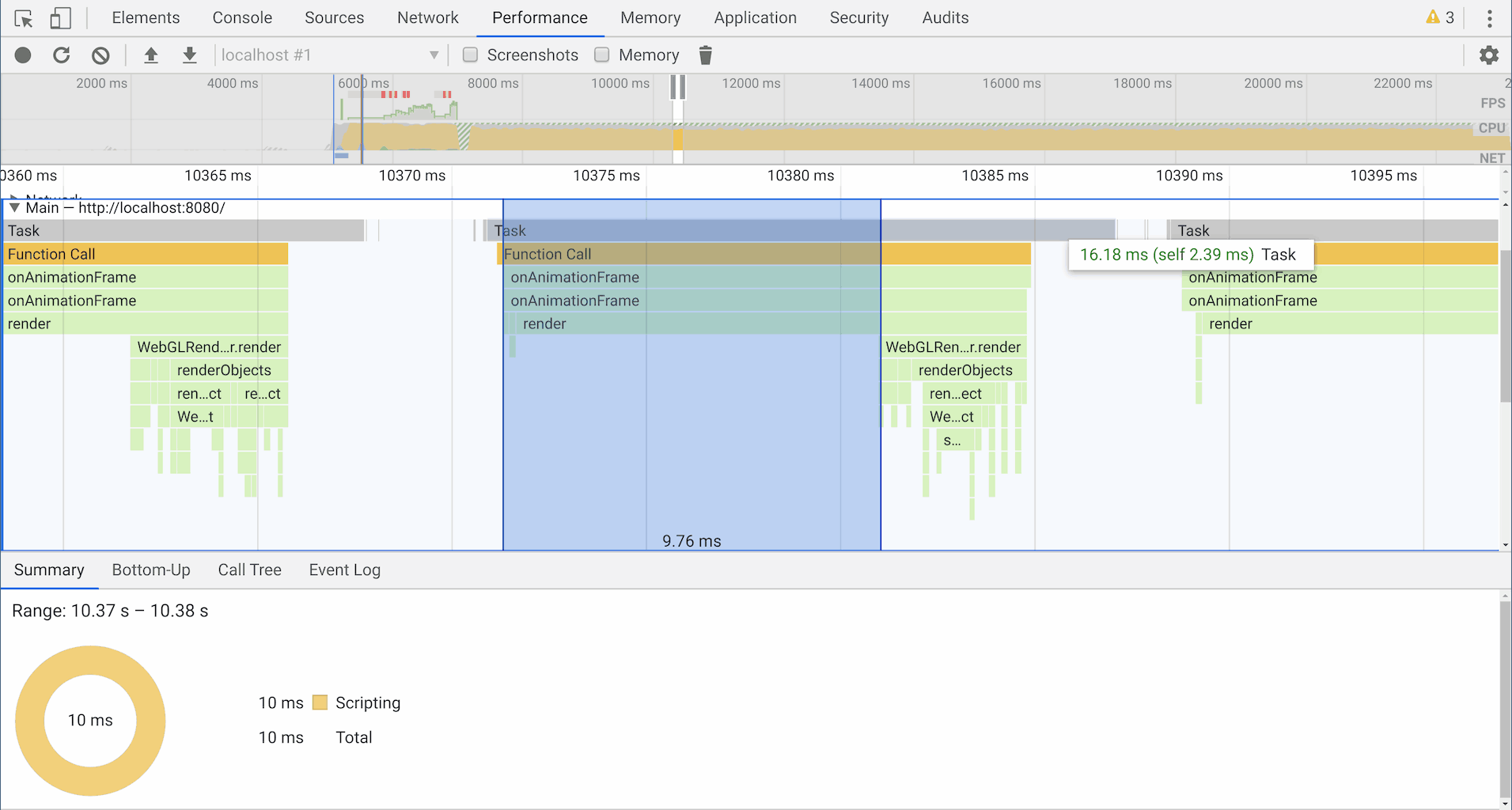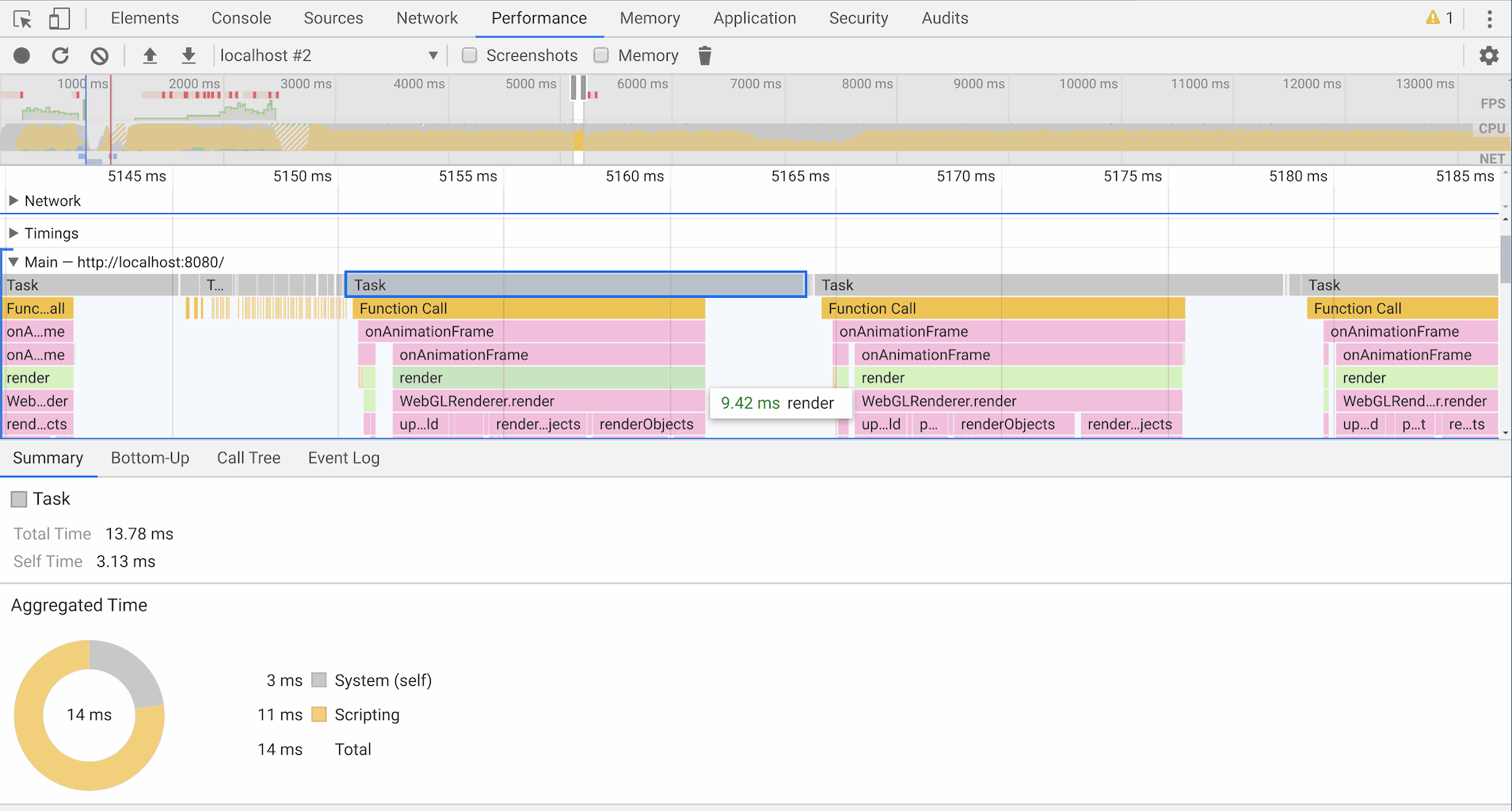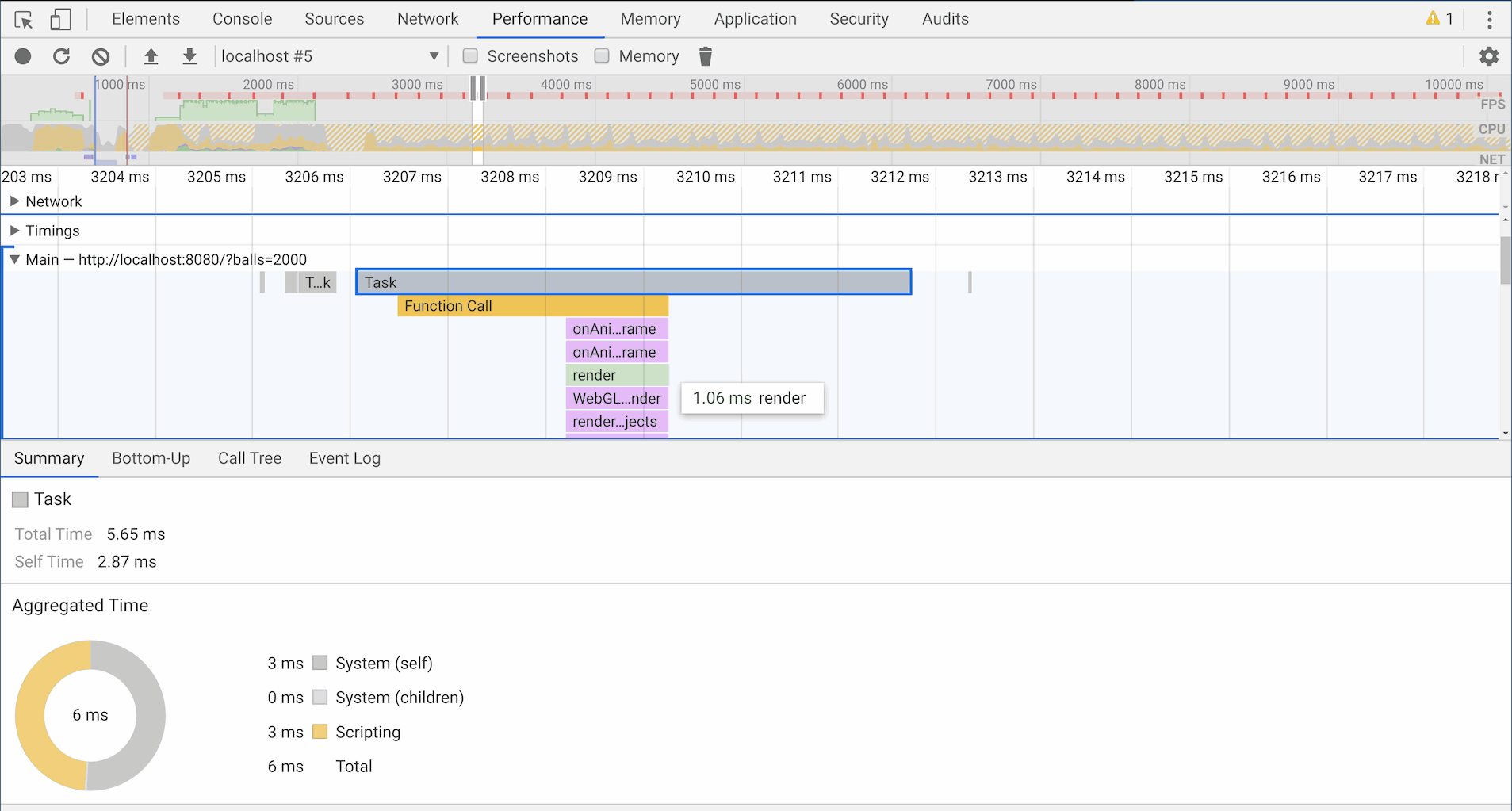Keeping the frame rate stable is vital for virtual reality applications. Off-main-thread architecture can help ensure that the frames keep shipping.
Note: Looking for the final version? Play it or read the source.
I recently became an owner of the Oculus Quest, and since the browser that comes with it has support for WebXR, I thought it only sensible to play around with that API. I looked at the Three.js examples and tried out the XR samples. Annoyingly, even the rather bare-bones Ballshooter was fun. However, I felt like it didn’t have enough balls. Time to start hacking!
threejs.orgMoar balls
I ripped out the demo from the repository so I could set up Rollup to handle workerization using my rollup-plugin-off-main-thread plugin. I also used this opportunity to run prettier (what were you thinking, Mr.doob? Just kidding.) and refactor the code a bit to give me a bunch of top-level variables to fiddle with:
// Field of View
var fov = 50;
// Number of balls;
var ballCount = 200;
// Radius of one ball
var radius = 0.08;
// Size of the room
var roomSize = 6;
// Loss of velocity when bouncing of walls
var dampening = 0.8;
Note: All steps of this case-study are captured in a gist that you can check out and go through commit by commit, if you want.
The next step is obviously to increase the number of balls:
- var ballCount = 200;
+ var ballCount = 2000;
This yields a horrible, even nauseating experience:
Whatever the game is doing takes way too long and so the Quest’s browser can’t ship a frame in time to update the canvas. You should never have to stare into the void as you can on the edges of the video above, and have to wait until the canvas snaps back into place. This harsh criticism is obviously unfair towards the authors of this game, which was never meant to be more than a VR sample app and prioritizes readable code above all else.
But where exactly are we losing time? Let’s scale things a bit back (to 500 balls to be exact) so we can still bear to play the game but also take a look at the trace:

Looking at the trace, each frame takes around 16ms when running with 500 balls. Which in the normal web world would be fine, although definitely cutting it close. In the VR world however, we have different frame rates. The Oculus Quest specifically runs at 72Hz. Most VR headsets actually run at 90Hz, some even higher. That means that we have 11.1ms per frame for VR and the current code is blowing through that budget.
Note: More experienced WebGL developers will feel the urge to point out that the example code does not make use of instanced rendering. That is correct and I’ll switch to instanced rendering later in the blog post.
This is the same problem I talked about in my previous blog post on workers: The performance metrics of the device you run are not under your control and the amount of time your code takes to run is unpredictable. This is a concern on the web as I have explained in that blog post, but it becomes a detrimental problem for virtual reality. An unsteady frame rate can cause nausea for the user and will render the app unusable. It is vital to avoid dropping frames at all costs. How do we do that?
Adding a worker
To nobody’s surprise, this is all just an excuse to talk some more about workers and off-main-thread architecture. As I proclaimed in my Chrome Dev Summit 2019 talk, the mantra is “the UI thread is for UI work only”. The UI thread will run Three.js to render the game using WebGL and will use WebXR to get the parameters of the VR headset and the controllers. What should not run on the UI thread are the physics calculations that make the balls bounce off the wall and off each other.
The physics engine is tailored to this specific app. It is effectively hard-coded to handle a number of balls of the same size in a fixed size room. The implementation is as straight forward as it is unoptimized. We keep all the balls’ positions and velocities in an array. Each ball’s velocity is changed according to gravity, each ball’s position is changed according to its velocity. We check all pairings of balls if they intersect (can you say ?), and if they do, the balls are separated and their velocity is changed as if they bounced off of each other.
Moving this code to a worker is doable as it is purely computational and doesn’t rely on any main thread APIs. Since we don’t have a requestAnimationFrame() in a worker, we will have to make due with good old setTimeout(). We’ll run the physics simulation at 90 ticks per second to make sure we can deliver a fresh frame to the majority of VR devices.
Note:
requestAnimationFramehas been made available in Workers in Chrome, but that’s the only browser that implemented this. But even if all browsers had that, it would run at the framerate of the web renderer, not necessarily of the VR headset itself. HMD-coupled rAF for workers is something I’d love to see specified in the WebXR API.
With Comlink, it is easy to expose multiple functions or class methods from the worker. But the question is in what form we send all the updated positions to the UI thread. We could take the naïve approach and just send a JavaScript array containing the positions for all balls on every frame. A quick estimation based on the rule of thumb reveals: Structured cloning an array of that size would put us at risk of blowing our frame budget at 60fps (let alone 72fps or even 90fps). And that’s just cloning time without any rendering. For a hot paths like this, structured cloning with big objects can often be a bottleneck.
ArrayBuffer
ArrayBuffer are a continuous chunk of memory. Just a bunch of bits. Using ArrayBuffer views you can interpret that chunk of memory in different ways. Using Int8Array you can interpret it as a sequence of 8-bit signed integers, using Float32Array you can interpret it as a sequence of 32-bit IEEE754 floats. Because ArrayBuffers map to a continuous chunk of memory, they are extremely fast to clone.
If you thought I was going to talk about transferring ArrayBuffer, I can’t blame you. That was the plan! In my very first implementation I actually did transfer the ArrayBuffers and built a memory pool so I can reuse memory buffers. However, I realized that before sending the buffer over to the main thread I had to create a copy: I need the positions on the main thread to render the next frame and in the worker for the next tick of the physics calculations. So instead of making a copy myself and transferring buffers, I let the structured cloning algorithm take care of the copying. I discovered that it performed just as well which allowed me to get rid of the code for the memory pool and made the overall code simpler to read.
With this out of the way, we can create two Float32Arrays in our worker, one for the balls’ positions and one for the velocities.
Pull model
My first attempt would let the physics calculation run and the main thread would pull the latest positions from the worker whenever it wants to ship a frame. This turned out to be a bad idea. Remember: The whole point is that we want the main thread to be unblocked, always able to ship a frame to keep the frame rate steady. With a pull model the main thread occasionally had to wait until the worker was available to reply to the main thread’s request. The main thread should never have to wait for anything.
Push model
Instead a push model is much more appropriate here. The main thread will register a callback with the worker to receive the updated positions. The rendering loop will just use whatever data is available. If the main thread hasn’t received an update, the balls will not move from one frame to the next and appear to be frozen in place. That’s not ideal, but at least allows us to incorporate fresh positional data from the WebXR API in case the user has moved their head and rerender the scene. This is crucial to avoid nausea.
Overall, the worker looked like this:
import * as Comlink from "comlink";
class BallShooter {
constructor() {
this._positions = new Float32Array(3 * this._numBalls);
this._velocities = new Float32Array(3 * this._numBalls);
// Prepare views onto the main buffers for each ball
this._balls = Array.from({ length: this._numBalls }, (_, i) => {
return {
index: i,
// `subarray()` creates a view onto the same memory
position: this._positions.subarray(i * 3 + 0, i * 3 + 3),
velocity: this._velocities.subarray(i * 3 + 0, i * 3 + 3)
};
});
this._init();
}
setCallback(cb) {
this._cb = cb;
}
_init() {
// Initialize balls’ positions and
// velocities with random values
}
start() {
// Schedule _update() at 90Hz
}
getPositions() {
return this._positions;
}
_update(delta) {
this._doPhysics(delta);
this._cb(this._positions);
}
_doPhysics(delta) {
// Take a wild guess
}
}
Comlink.expose(BallShooter);
A simplified version of the main script looks like this:
import * as THREE from "three";
import * as Comlink from "comlink";
const worker = new Worker("./worker.js");
const BallShooter = Comlink.wrap(worker);
let positions;
// ... more variables
init().then(() => animate());
async function init() {
ballShooter = await new BallShooter();
scene = new THREE.Scene();
// ... ThreeJS stuff ...
positions = await ballShooter.getPositions();
updateBallPositions();
await ballShooter.setCallback(
Comlink.proxy(buffer => {
positions = buffer;
});
);
}
function updateBallPositions() {
for (var i = 0; i < room.children.length; i++) {
var object = room.children[i];
object.position.x = positions[i * 3 + 0];
object.position.y = positions[i * 3 + 1];
object.position.z = positions[i * 3 + 2];
}
}
function animate() {
renderer.setAnimationLoop(render);
ballShooter.start();
}
async function render() {
updateBallPositions();
renderer.render(scene, camera);
}
So far so good! The physics calculations now run in a worker, ensuring that our framerate remains stable and our VR users don’t throw up. However, the balls just fall down from their initial positions and bounce around a little. The controllers do nothing.
Accessing the controllers
To be able to shoot balls, the worker needs to know the positions and rotations of the controllers so it can make balls shoot through the room. Because the WebXR API is not available in a worker, we have to forward that data ourselves.
On the main thread we just send the position and quaternion of each controller on every frame as an array. Because these are arrays with 3 or 4 elements, the structured cloning time is negligible. If it does become a problem, we could switch to ArrayBuffers here as well, but that didn’t turn out to be necessary.
async function init() {
// ...
controller1.userData.id = 0;
controller1.addEventListener("selectstart", onTriggerDown);
controller1.addEventListener("selectend", onTriggerUp);
controller2.userData.id = 1;
controller2.addEventListener("selectstart", onTriggerDown);
controller2.addEventListener("selectend", onTriggerUp);
// ...
}
function onTriggerDown() {
ballShooter.startShootingGun(this.userData.id);
}
function onTriggerUp() {
ballShooter.stopShootingGun(this.userData.id);
}
function updateController(controller) {
ballShooter.setGun(
controller.userData.id,
controller.position.toArray(),
controller.quaternion.toArray()
);
}
async function render() {
updateController(controller1);
updateController(controller2);
// ...
}
In the worker, we need to handle these signals accordingly:
class BallShooter {
constructor() {
// ...
this.shootingRate = 10;
this._guns = [
{
shooting: false,
position: new THREE.Vector3(),
quaternion: new THREE.Quaternion()
},
{
shooting: false,
position: new THREE.Vector3(),
quaternion: new THREE.Quaternion()
}
];
// ...
}
startShootingGun(id) {
this._guns[id].shooting = true;
}
stopShootingGun(id) {
this._guns[id].shooting = false;
}
setGun(id, position, quaternion) {
this._guns[id].position.set(...position);
this._guns[id].quaternion.set(...quaternion);
}
_update(delta) {
this._doPhysics(delta / 1000);
this._shootBalls(delta / 1000);
this._cb(this._positions);
}
_shootBalls(delta) {
for (const gun of this._guns) {
if (!gun.shooting) {
continue;
}
// Move a ball to the controller’s position
// and set the ball’s velocity along the
// controller’s axis.
}
}
}
Note: Another feature request for the WebXR API: I’d love to get access to the positional data (both for the HMD and the controllers) in a worker. Since those are tied to a XR session, I’m not sure if that is easily possible, though.
We have now fully replicated the functionality of the original game, with the physics calculations are isolated to a worker.
Running it all
With all of that in place, we can play the game just as before. But does it behave any better when increasing the number of balls to 2000? What you get I’d call unenjoyable but nausea-free:
We still see glimpses of the void at the corners, but they disappear immediately (and are not visible from within the headset). Looking at a trace quantifies what we have just seen: We are just barely inside our main thread budget and the physics just take way too long, but are isolated.


I won’t go into optimizing the physics. There is a lot of material out there on this topic. But what we should take a look at is the main thread budget. There’s pretty much no headroom left, and if the Oculus Quest was running at 90Hz, we’d be screwed.
Instanced rendering
Currently, each ball is drawn individually, causing a large number of draw calls. This is one of the more common optimizations you can look at when writing OpenGL. To batch similar objects into one draw call, you can use a technique called instanced rendering. ThreeJS now has support for this technique with their new InstancedMesh. Conveniently, WebGL and consequently InstancedMesh works with ArrayBuffers, allowing us to pass the data we get from the worker straight to WebGL, without having to loop over it.
async function init() {
// ...
const geometry = new THREE.IcosahedronBufferGeometry(radius, 2);
const balls = new THREE.InstancedMesh(
geometry,
new THREE.MeshLambertMaterial({
color: 0xff8000
}),
ballCount
);
// ThreeJS doesn't support frustum culling for InstancedMesh yet.
balls.frustumCulled = false;
room.add(balls);
ballShooter.setCallback(positions => {
balls.instanceMatrix.array.set(positions);
balls.instanceMatrix.needsUpdate = true;
});
// ...
}
One additional adjustment is the fact that InstanceMesh expects an array of 4x4 matrices instead of just the position. To accommodate this, we need to grow buffers we send from the worker to ~5 times the original size — from 3 floats per ball to 16 floats per ball. Luckily, this has no measurable impact on performance due to how fast ArrayBuffers are to copy. At the same time, the switch to instanced rendering freed up our main thread dramatically (which won’t surprise anyone with OpenGL experience):

At this point the main thread is free to render a more complex scene, more balls or whatever you want to do. We will have to optimize the way our physics calculations are done to make it enjoyable, but that’s a story for another time.
The only downside of switching to instanced rendering is that ThreeJS’s can only render all instances with the same material. Mr.doob said it’s on his list of things to fix. For now, all balls will remain orange. If you want to play the final, off-main-thread version of this game with instanced rendering, you can check it out here.
Conclusion
I think I had an interesting realization throughout this experiment: If structured cloning is a bottleneck for you, switching to transferables is not the only alternative. ArrayBuffers are so fast to copy that they might be simple but effective optimizations over JSON-like objects. Only if your buffers are really big will you see a difference between copying and transferring.
Gaming in general and VR specifically doesn’t only seem to benefit from an off-main-thread architecture, it seems to me that it is a requirement. Especially for VR it is absolutely critical to keep the render loop going to avoid making your users unwell. With more and more VR devices coming to the market, the variance in performance will only increase, just like it did for mobile phones. The amount of time of your code takes will become more and more unpredictable. Off-main-thread architecture can help you make your app more resilient.